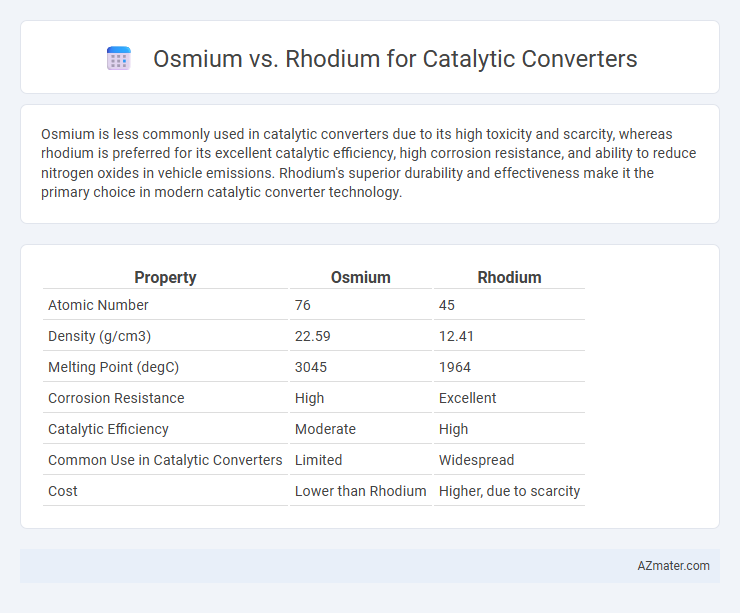Osmium is less commonly used in catalytic converters due to its high toxicity and scarcity, whereas rhodium is preferred for its excellent catalytic efficiency, high corrosion resistance, and ability to reduce nitrogen oxides in vehicle emissions. Rhodium's superior durability and effectiveness make it the primary choice in modern catalytic converter technology.
Table of Comparison
| Property | Osmium | Rhodium |
|---|---|---|
| Atomic Number | 76 | 45 |
| Density (g/cm3) | 22.59 | 12.41 |
| Melting Point (degC) | 3045 | 1964 |
| Corrosion Resistance | High | Excellent |
| Catalytic Efficiency | Moderate | High |
| Common Use in Catalytic Converters | Limited | Widespread |
| Cost | Lower than Rhodium | Higher, due to scarcity |
Introduction to Osmium and Rhodium in Catalytic Converters
Osmium and Rhodium are rare transition metals known for their exceptional catalytic properties in automotive catalytic converters. Rhodium is widely used for its remarkable ability to reduce nitrogen oxides (NOx) emissions, while Osmium's potential catalytic applications focus on oxidation reactions but are limited due to its toxicity and rarity. In catalytic converter technology, Rhodium remains the preferred choice for efficient NOx reduction, contributing significantly to emission control and environmental compliance.
Chemical Properties: Osmium vs Rhodium
Osmium exhibits a high density and excellent corrosion resistance but forms volatile and toxic osmium tetroxide under oxidation, limiting its catalytic use compared to rhodium. Rhodium has superior catalytic activity and stability in harsh oxidative environments, making it more effective for catalytic converters in reducing nitrogen oxides and promoting oxidation of pollutants. The chemical durability and selectivity of rhodium enhance its functional longevity and efficiency in exhaust gas treatment relative to osmium's reactive and less stable nature.
Catalytic Efficiency Comparison
Osmium and rhodium exhibit distinct catalytic efficiencies in catalytic converters, with rhodium demonstrating superior performance in reducing nitrogen oxides (NOx) due to its higher selectivity and stability under high-temperature conditions in automotive exhaust systems. Osmium, while effective as a catalyst, is less commonly used due to its lower resistance to oxidation and reduced catalytic activity compared to rhodium. The enhanced catalytic efficiency of rhodium significantly contributes to the improved emission control and durability of catalytic converters in modern vehicles.
Durability and Longevity of Osmium and Rhodium
Rhodium demonstrates superior durability and longevity in catalytic converters due to its exceptional resistance to high temperatures and corrosion, maintaining catalytic efficiency over extended periods. Osmium, while rare and dense, is less stable under catalytic converter operating conditions, prone to oxidation and chemical wear, which reduces its lifespan in automotive applications. The proven resilience of rhodium under harsh exhaust environments makes it the preferred choice for long-lasting catalytic converter performance.
Cost Analysis: Osmium vs Rhodium
Rhodium is significantly more expensive than osmium, with rhodium prices often exceeding $500 per gram compared to osmium's market value around $20 per gram. This cost disparity impacts the overall expense of catalytic converters, making osmium a potentially more budget-friendly alternative despite its lower catalytic efficiency. The high price volatility of rhodium also adds financial risk, whereas osmium offers more price stability in catalytic converter applications.
Environmental Impact and Emissions Reduction
Osmium and rhodium are both used in catalytic converters, but rhodium leads in environmental impact due to its superior effectiveness in reducing harmful nitrogen oxides (NOx) emissions. Rhodium's high catalytic activity lowers toxic pollutants more efficiently, contributing to stricter emissions standards compliance and improved air quality. Osmium, while rare and dense, poses higher toxicity risks and less catalytic performance, making rhodium the preferred choice for emissions reduction in automotive applications.
Availability and Sourcing of Osmium and Rhodium
Osmium is significantly rarer and less commercially available than rhodium, with global production limited to a few mining operations primarily in Russia and South Africa. Rhodium, widely sourced as a byproduct of platinum and nickel mining, has a more established supply chain supported by major producers in South Africa, Russia, and Canada. The scarcity and complex extraction process of osmium make rhodium a more practical choice for catalytic converters, ensuring better availability and consistent sourcing for automotive manufacturers.
Industrial Applications and Preferences
Osmium and rhodium are both platinum-group metals utilized in catalytic converters, with rhodium preferred due to its superior resistance to high-temperature oxidation and enhanced catalytic efficiency in reducing nitrogen oxides emissions. Industrial applications favor rhodium for its ability to maintain long-term durability under harsh exhaust conditions, making it a critical component in automotive emission control systems. Osmium's rarity and brittleness limit its use in catalytic converters, positioning rhodium as the dominant choice in industrial catalytic converter manufacturing.
Safety and Handling Considerations
Osmium and rhodium are both used in catalytic converters for their excellent catalytic properties, but rhodium is preferred due to its superior safety profile and easier handling. Osmium poses significant safety risks as it can form toxic osmium tetroxide, a highly volatile and harmful compound requiring stringent handling protocols and specialized ventilation. Rhodium's inertness and lower toxicity make it safer for industrial use, reducing health hazards and simplifying storage and disposal procedures.
Future Trends in Catalytic Converter Materials
Osmium and rhodium are critical platinum-group metals used in catalytic converters, with rhodium currently favored for its superior performance in reducing nitrogen oxides (NOx) emissions. Future trends indicate increasing research into osmium's potential due to its high density and catalytic stability, aiming to enhance converter durability under extreme conditions. Advancements in nanotechnology and alloy development are driving innovations toward cost-effective, efficient catalysts that may integrate osmium to complement or partially replace rhodium in automotive emission control systems.

Infographic: Osmium vs Rhodium for Catalytic Converter
 azmater.com
azmater.com